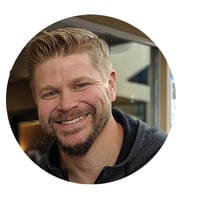Posted in: Aha! Blog > Wit & Wisdom Blog > Data Stories High-Quality Curriculum > Making the Shift to a Content-Focused Curriculum
When it came time to select a new English language arts curriculum during the 2019–2020 school year, educators at Clayton Elementary School in southwest metro Denver were ready.
CLAYTON ELEMENTARY SCHOOL ENGLEWOOD SCHOOLS
ENGLEWOOD, COLORADO
- 425 STUDENTS IN GRADES K–6
- 70% LOW-INCOME
- 20% ELL
- 13% SPED
- Adopted Wit & Wisdom and Geodes beginning in the 2020-2021 school year.
They had seen the limitations of the previous materials. “(The prior curriculum) was not meeting needs,” says Rachel Arnold, the school’s literacy interventionist. Teachers and curriculum specialists had spent a couple of years looking closely at the latest research about the science of reading and effective instruction. They read Natalie Wexler and others who extolled the value of a knowledge-based curriculum, where students read comprehensive texts that focus on learning content rather than isolated skills practice.
 “Wit & Wisdom® was the cherry on top of a huge shift already under way here,” says Arnold, who singles out the materials’ rich, rigorous content and explicit writing instruction along with the related substantial Geodes® books for early readers.
“Wit & Wisdom® was the cherry on top of a huge shift already under way here,” says Arnold, who singles out the materials’ rich, rigorous content and explicit writing instruction along with the related substantial Geodes® books for early readers.
“The team was thrilled to add this resource to our academic program at Clayton,” adds Assistant Principal Matt Hoganson, who had used Wit & Wisdom in his previous role as a dean of students in nearby Aurora Public Schools. That the school also emphasized arts integration and had been strengthening its commitment to social and emotional learning (SEL) were added benefits. “Wit & Wisdom was intentionally chosen because of its focus on equity and SEL,” says Arnold. “It spoke to all the work we had already started. It was a beautiful marriage of ideas.”
Overcoming Year One Challenges
Then came the 2020 pandemic, which complicated the roll-out. All teachers had two days of professional development during the summer, focused on the Launch Wit & Wisdom and Module and Lesson Study sessions. In September, students began school onsite, but all the Covid-19-related safety protocols left less time for classroom instruction. By November, the school had to shift to all-remote learning, using the version of the curriculum designed for that, with lessons tailored for reduced instructional hours.
“Wit & Wisdom in Sync has been a life-saver,” says Hoganson. “The lesson plans in the digital platform made it easier for teachers to make the transition to remote learning.”

Strong Student Engagement
Before students went home, Hoganson, Arnold, and their colleagues could see first-hand the impact of the new curriculum on student learning. “Student excitement skyrocketed. You could see it every day in the classrooms and during lunchtime conversations. They were having higher-level conversations. They had become experts in their content areas, and you could see their confidence grow,” Hoganson says.
The “joy of literacy” was contagious. Everyone was engaged: students, specialists, administrators, and classified staff such as paraprofessionals. “It was a new way of interacting for everyone,” he says.
Arnold is especially grateful that all students are learning from the same rigorous texts, not being siloed and short-changed with leveled readers. Although sensitive to students’ needs, teachers are being more deliberate about scaffolding lessons for English learners and students with special needs; they know it is essential to provide all students equitable access to high-quality literature, and the teachers are up to the challenge and believe in their students.
Hoganson points out that challenging texts at the earliest grades are critical because the complexity only intensifies as grades advance.
Making the Transition More Manageable
The transition has presented challenges beyond those caused by the pandemic. “We’re seeing productive struggle for every member of our school,” teachers and students alike, says Arnold. Teachers were excited about the shift from skill-based to content-driven curricula. Giving students more control over classroom discussion has required a new mindset. The school had already prioritized lesson planning and backward mapping, so understood the importance of module protocols as the key to learning goals. The Grade 6 team were the Wit & Wisdom pioneers, implementing the curriculum the year before, and their experience proved to be essential.
Strong support from Great Minds staff eased the transition, Hoganson says. A key implementation strategy clearly defined year one success and set a series of manageable goals. A five-step protocol of classroom look-fors also has helped. Bottom line: “Don’t overload your staff so that you’re crushing the joy of learning,” he advises.
Staff knew implementing a new curriculum would be challenging, especially since the school’s learning platform might change frequently because of Covid-19. The end-of-module tasks in Wit & Wisdom were more rigorous than what students were used to seeing. “We were all impressed and anxious about the depth of knowledge required,” says Arnold. “The teachers here at Clayton are truly phenomenal and knew students were capable of deep, thoughtful, and meaningful work. The exceptional texts and commitment to knowledge that Wit & Wisdom brings have allowed them to foster this level of excellence.”
Submit the Form to Print

Abbie Nilles
Abbie Nilles is a regional solutions manager at Great Minds, where she partners with schools and districts throughout Colorado and New Mexico to bring high-quality curriculum and support to teachers and students. Abbie was born and raised in Iowa and graduated from Iowa State University with a bachelor of science in Child, Adult, & Family Services. After graduating, Abbie spent time teaching in China and later back in the United States, where she realized her passion for education. Her experience in both higher education and K-12 education sales has provided her with the chance to work with dedicated educators throughout the country and truly understand their impact. She resides in Denver, Colorado, where she can continue cultivating partnerships with Colorado and New Mexico districts, but also spend time outdoors with her husband, running marathons and hiking.
Topics: Data Stories High-Quality Curriculum





.jpg?width=430&name=PhD%20Science%20(1).jpg)





.jpg?width=430&name=EurekaMath%20(1).jpg)
.jpg?width=430&name=WitWisdom%20(1).jpg)

